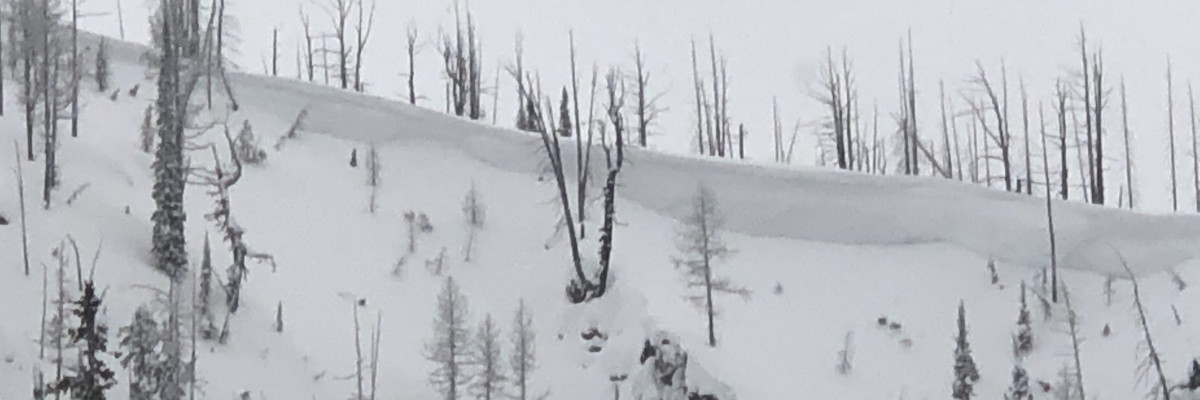The avalanche danger is MODERATE this morning trending to considerable by this afternoon in the west central Montana backcountry today. New snow and wind are creating dangerous avalanche conditions. Human triggered avalanches are possible this morning and become more likely this afternoon and tomorrow.
Good Morning. This is Travis Craft with the West Central Montana Avalanche Center advisory on Thursday, February 4, 2021. This advisory is sponsored by the Big Sky Brewing Company. This advisory does not apply to operating ski areas and expires at midnight tonight. The USDA Forest Service is solely responsible for its content.
Weather and Snowpack
Mountain temperatures range from 18 degrees to 25 degrees F this morning. 8 to 10 inches of new snow fell in the last 48 hours. Winds are 12 mph, gusting to 22 mph out of the SSW. Today and tonight, look for winds 15 mph gusting into the 30’s out of the West. 4-8 inches of snow are forecasted today and tonight with higher amounts above 7000 ft.
New snow and wind are elevating the avalanche danger. In the last 48 hours, the advisory area received 6 to 12 inches of new snow. This snow fell on a variety of old snow surfaces. In the southern and central Bitterroot, it fell on surface hoar. Use hand pits and small test slopes to see how the new snow is bonding to old snow surfaces. Winds are loading leeward aspects and creating sensitive wind slabs. These were observed yesterday in the central Bitterroot and Rattlesnake. Cornices are growing in size and should be given a wide berth. Avoid glide cracks.
The new snow is testing our buried weak layers. There is a lot of spatial variability from drainage to drainage and slope to slope. Yesterday near the Brushy Fork at 7000 ft to 7500 ft, I found snow depths from 3 ft to 5 and half feet deep depending on the aspect. The structures were all different. The shallowest snowpack had basal facets and propagated in my ECT near the ground. The deepest snowpack did not have this weak structure. These different depths show the variability in one drainage around an elevation band. We found weak, shallow snow in the Rattlesnake that propagated in ECT’s. Around Gash point, a facet crust combination propagated in tests at 7000 ft, and widespread collapsing was happening. The buried weak layers are becoming reactive with this new load of snow.
Today make it simple, avoid wind loaded slopes. Choose low angle slopes less than 30 degrees that have 4 to 5 feet of snow. Avoid slopes with shallow, weak snowpacks. Pay attention to changing weather conditions. Stay alert when changing aspect and elevation to the changes in snowpack’s depth and structure.
Bottom Line
Keep it simple today. Choose low angle slopes. Avoid slopes with weak sugary snow. Do multiple pits investigating the layers in your pit wall. Avoid cornices and wind loaded terrain. Choose simple terrain that does not expose you to terrain traps. Avoid likely trigger points on slopes.
Travel one at a time in avalanche terrain, carry a beacon, shovel, and probe. Remember to reassess conditions throughout the day and stay alert for signs of instability. Dig a pit. Look for red flags.
Upcoming Education Events:
Please visit our education page for an up to date list of regional educational events and course offerings. Below are a few select events and opportunities to check out.
- February 10th, 6-7:30 PM MST | FREE Online 1.5-hr Avalanche Awareness Session | Missoulaavalanche.org event | Delivered by A3 Pro instructors | Get more details and register HERE
Public Observations
Thank you to everyone who has taken the time to send in a public observation. Please keep sharing what you find and see while out in the backcountry. This online forum is a great resource to glean information about current conditions.
You can now text us your observations to (406) 219-5566 when you don’t have time to fill out the observations page. Texted observations won’t get posted on the website, but will be used in the development of the forecast.
Ski and ride safe.














